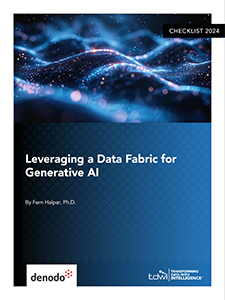
TDWI Checklist Report | Leveraging a Data Fabric for Generative AI
June 28, 2024
The introduction of generative AI has changed the landscape of AI.
Use cases for generative AI are now starting to move past simpler chatbots and employee onboarding systems toward implementations that require company data about customers or products. For example, a chatbot might be enhanced to include customer loyalty information to provide modified responses based on who the chatbot is conversing with.
To effectively implement this type of AI, you must have a solid data foundation. A hybrid data environment further complicates building generative AI models with company data. How do you find data relevant to the question being asked when it is distributed among systems, stored in various formats, and requires different access methods? How do you ensure that data provided to a generative AI model is accurate and timely?
This TDWI Checklist Report explores how to implement generative AI applications using a logical architectural approach such as a data fabric together with techniques such as retrieval-augmented generation.